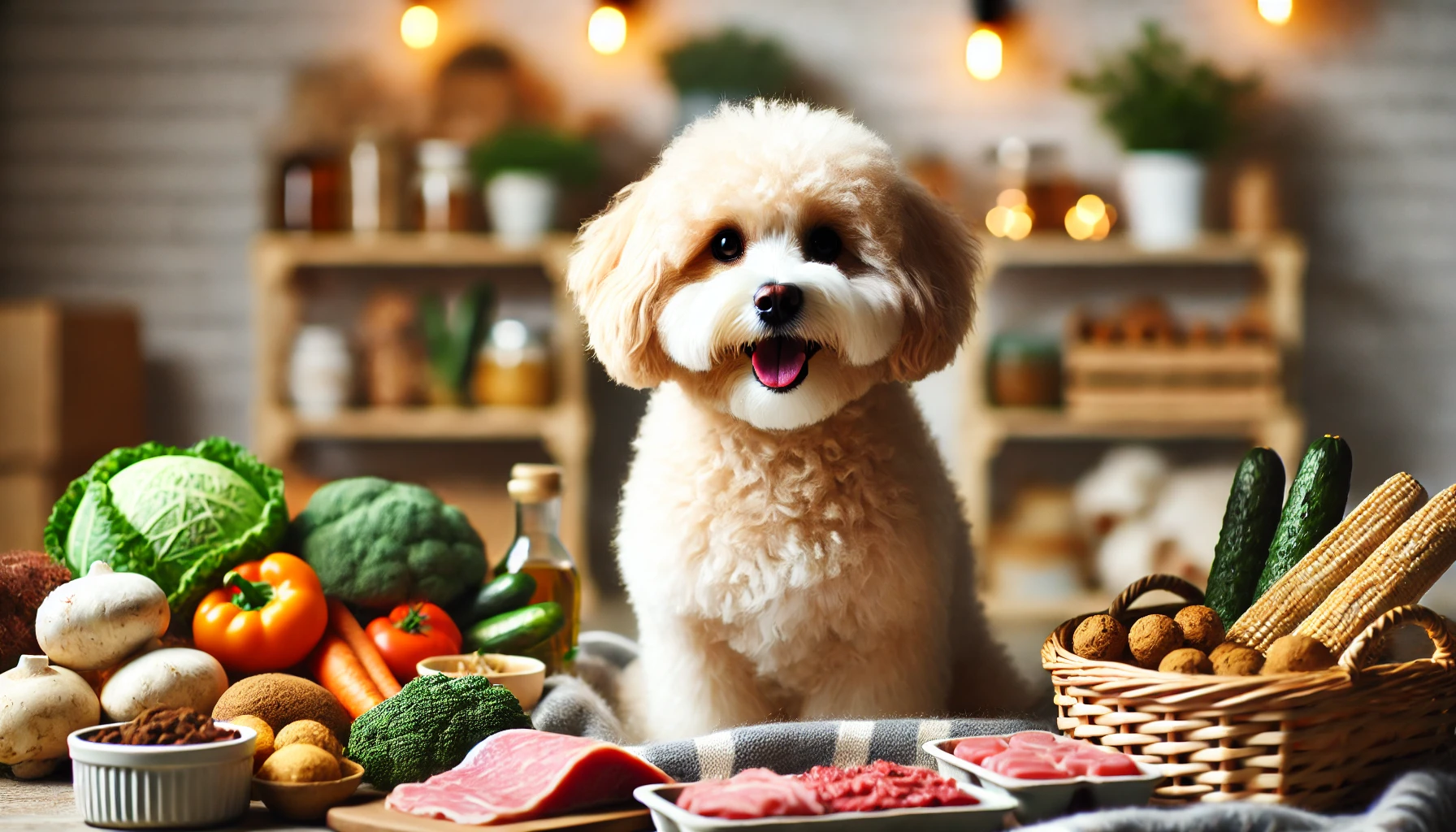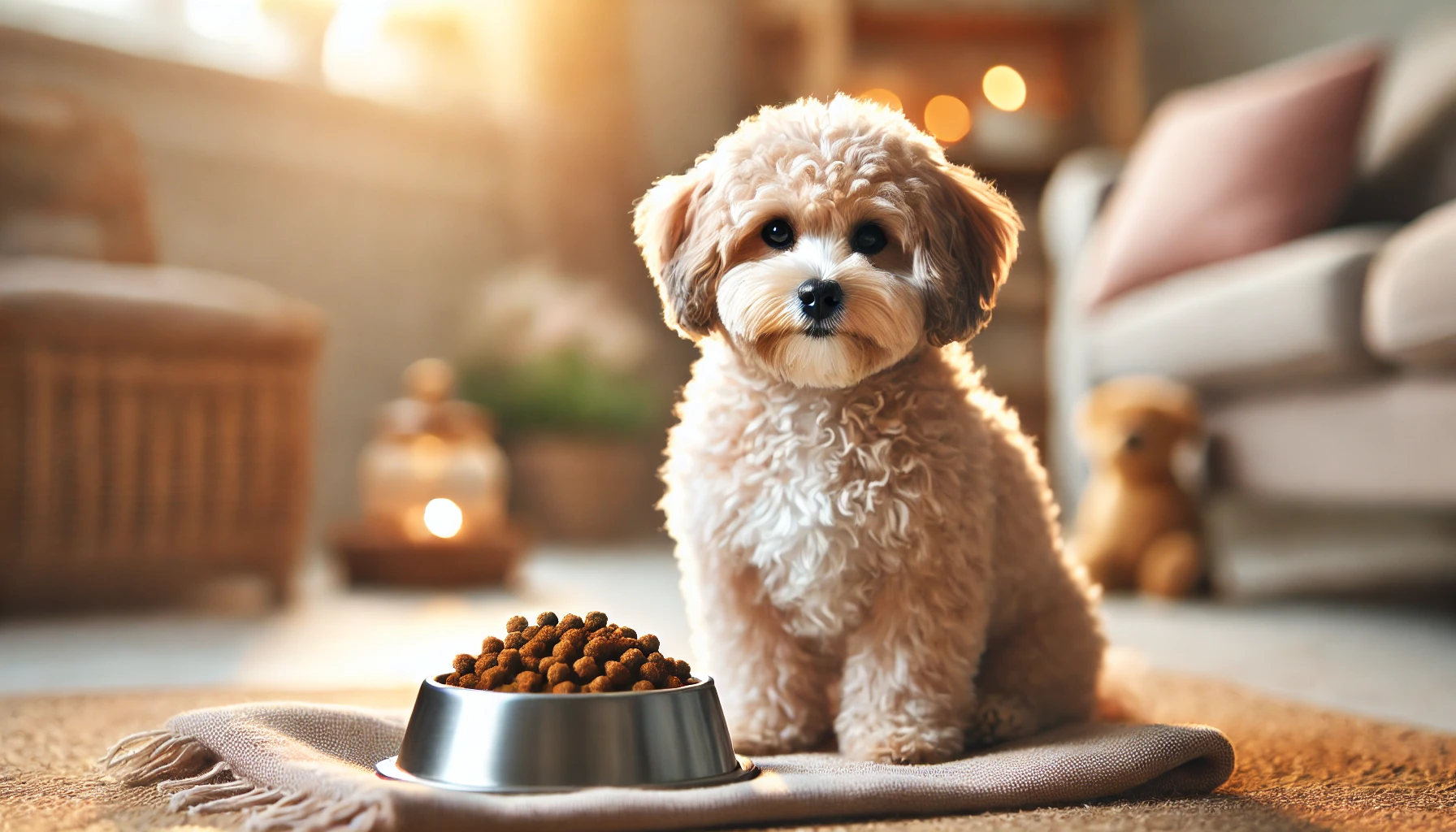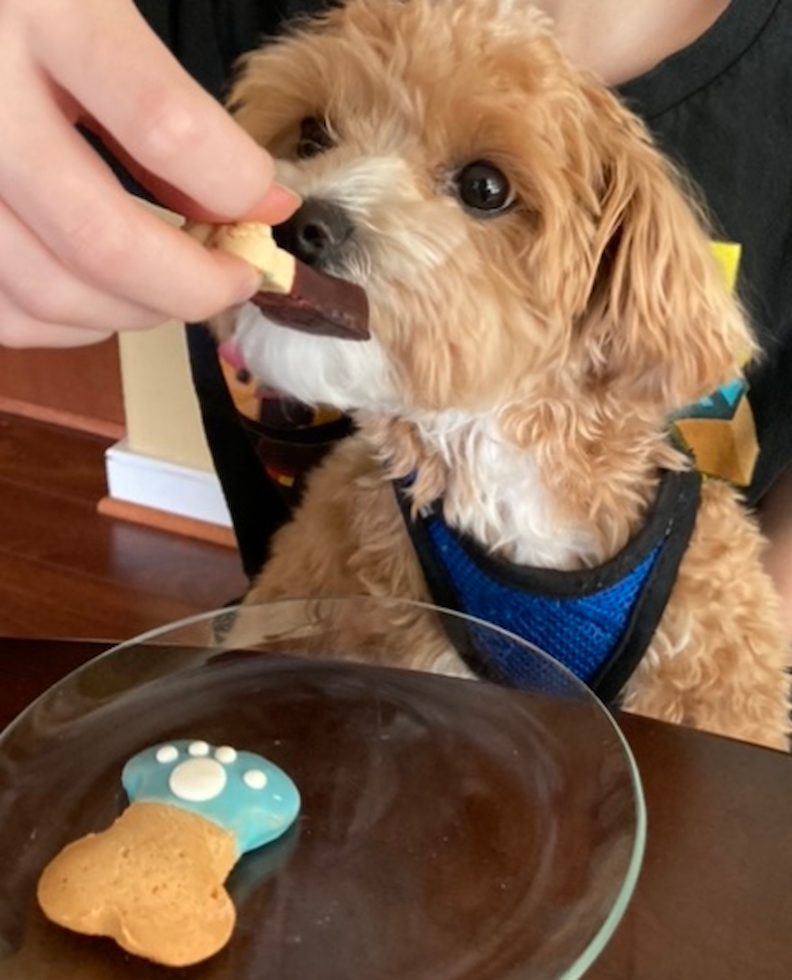
Did you know that choosing the right food for your Maltipoo is one of the most important decisions you’ll make as a pet owner? With their playful personalities and unique needs as a small breed, Maltipoos thrive on a diet tailored to their size, energy levels, and nutritional requirements. But with so many options available, it’s easy to feel overwhelmed.
Feeding your Maltipoo isn’t just about providing meals—it’s about ensuring they live their best, healthiest life. From selecting the right type of food to understanding portion sizes and feeding schedules, there’s a lot to consider. That’s where this guide comes in.
In this article, you’ll find everything you need to make informed decisions about your Maltipoo’s diet. Whether you're curious about dry kibble, wet food, or even homemade recipes, we’ve got you covered. Plus, we’ll share tips on choosing high-quality ingredients, managing portion sizes, and incorporating treats without overdoing it.
Table of Contents
- Essential Nutrients for Maltipoos
- Feeding Your Maltipoo Through Every Life Stage
- Understanding Portion Sizes
- Choosing the Best Food for Your Maltipoo
- Managing Food Allergies and Sensitivities in Maltipoos
- Incorporating Treats into Your Maltipoo’s Diet
- Ensuring Proper Hydration for Your Maltipoo
- Special Dietary Considerations for Your Maltipoo
- Transitioning Your Maltipoo to a New Diet
- Homemade Diets for Your Maltipoo
- Conclusion
Essential Nutrients for Maltipoos

AI image of a Maltipoo dog: generated with ChatGPT.
Your Maltipoo’s health and happiness start with the nutrients in their bowl. Like a perfectly balanced recipe, their diet needs to combine the right ingredients in just the right amounts. Proteins, fats, carbohydrates, vitamins, and minerals all work together to fuel their energy, support their coat, and keep them feeling their best.
Protein
Think of protein as the cornerstone of your Maltipoo’s diet. It provides the building blocks for strong muscles, boundless energy, and overall growth. High-quality animal proteins like chicken, turkey, and fish are ideal, offering the amino acids your pup needs to stay active and playful.
Fats
Healthy fats are like a double-duty ingredient—they provide energy for your Maltipoo’s adventures and help maintain that silky, soft coat you love. Omega-3 and omega-6 fatty acids, found in sources like fish oil and chicken fat, also support their brain and joint health.
Carbohydrates
Carbohydrates are your Maltipoo’s go-to for steady energy throughout the day. Complex carbs like sweet potatoes and brown rice are gentle on their stomachs and keep their energy levels consistent, perfect for small dogs with big personalities.
Vitamins and Minerals
Though they may not take center stage, vitamins and minerals are essential for your Maltipoo’s overall well-being. From supporting a strong immune system to promoting healthy teeth and bones, these nutrients often come from wholesome fruits, vegetables, and carefully formulated dog foods.
The Importance of Hydration
Don’t forget water—it’s the one nutrient that often gets overlooked but is just as important as their food. Always make sure your Maltipoo has access to clean, fresh water, especially if they’re active or eating dry food. Wet food can also help keep them hydrated if they’re not a big fan of drinking water on their own.
RELATED: Puppy Feeding Guide
Feeding Your Maltipoo Through Every Life Stage

AI image of three Maltipoos at different life stages: generated with ChatGPT.
As your Maltipoo grows, their dietary needs will change to match their age, activity level, and health. Whether you’re feeding a bouncy puppy, an active adult, or a calm senior, tailoring their diet to their life stage is key to keeping them healthy and happy.
Puppy Stage
Maltipoo puppies are bundles of energy, constantly exploring and playing. During this stage, their bodies are growing quickly, and they need a diet packed with nutrients to fuel their development. Puppy-specific dog food is specially formulated with higher levels of protein, fat, and calories to support their rapid growth. Frequent meals—about three to four small servings a day—help keep their energy steady and prevent their tiny stomachs from becoming overwhelmed.
Adult Stage
By the time your Maltipoo reaches adulthood, their nutritional needs shift to maintaining their energy and overall well-being. Two balanced meals a day are usually enough to keep them satisfied. Look for dog food labeled for small breeds, as these formulas are designed to deliver the right nutrients in smaller portions. Monitoring their weight and activity level can help you adjust their portions if needed, ensuring they stay in tip-top shape.
Senior Stage
As Maltipoos get older, their metabolism slows down, and they may become less active. Senior dog food formulas often have fewer calories but are rich in nutrients that support joint health and digestion. At this stage, it’s important to keep an eye on their weight and adjust portion sizes or food choices as needed to maintain their health and mobility. Regular vet check-ups can also help ensure their diet is meeting all their needs.
Portion Sizes and Feeding Schedules for Maltipoos
Finding the right balance between portion sizes and feeding schedules is crucial to keeping your Maltipoo healthy and satisfied. Overfeeding can lead to unnecessary weight gain, while underfeeding might leave your pup feeling hungry and low on energy. Thankfully, with a little attention to their unique needs, you can create a feeding routine that works perfectly for your furry friend.
RELATED: 20 Pros and Cons of Owning a Maltipoo
Understanding Portion Sizes
The right portion size depends on a few factors, like your Maltipoo’s age, weight, activity level, and even their metabolism. Puppies, for example, burn through energy quickly and need smaller, more frequent meals, while adult Maltipoos can thrive on two consistent meals a day. As a general rule, always check the feeding guidelines on your dog food’s packaging, but don’t be afraid to adjust based on how your Maltipoo looks and feels.
Pay attention to their body condition. If their ribs are easily felt but not sticking out, they’re likely at a healthy weight. If they start looking too round or too lean, it’s time to adjust their portions slightly. Consistency is key—feed them the same amount at the same times every day to keep their digestion regular and avoid overeating.
Establishing a Feeding Schedule
Maltipoos thrive on routine, and a regular feeding schedule can help them feel secure and maintain steady energy levels throughout the day.
- For Maltipoo Puppies: Divide their daily food into three or four meals spread evenly across the day. This keeps their energy levels balanced and prevents overeating in one sitting.
- For Maltipoo Adults: Two meals a day, one in the morning and one in the evening, is usually enough to keep them full and happy.
- For Maltipoo Seniors: Stick to two meals, but consider slightly smaller portions if they’re less active than they used to be.
Make sure to pick a quiet, comfortable spot for feeding time. Distractions or stress can lead to picky eating or digestive upset. Fresh water should always be available alongside their meals.
Choosing the Best Food for Your Maltipoo

AI image of a Maltipoo dog: generated with ChatGPT.
Once you’ve nailed down portion sizes and a feeding schedule, the next step is selecting the right food to fill your Maltipoo’s bowl. With countless options on the market, it can feel overwhelming to decide what’s truly best for your furry friend. From dry kibble to wet food and even homemade options, the key is choosing high-quality, nutrient-rich food that meets their unique needs.
Dry Kibble
Dry kibble is a popular choice for Maltipoos, and for good reason. It’s easy to store, simple to serve, and helps support dental health by reducing plaque buildup. When choosing kibble, look for a formula designed specifically for small breeds. These are crafted with smaller bites that are easier for Maltipoos to chew and digest. The ingredient list should start with a real protein source like chicken, lamb, or fish and avoid fillers like corn or soy.
Wet Food
Wet food can be an excellent option, especially if your Maltipoo is a picky eater or needs extra hydration. Its rich flavors and softer texture are often more appealing to dogs, making it a great supplement to dry kibble or a stand-alone meal. Just be mindful of portion sizes, as wet food tends to have more calories per serving than kibble.
Homemade Meals
For owners who want complete control over their Maltipoo’s diet, homemade meals can be a wonderful choice. These allow you to tailor every ingredient to your dog’s needs, ensuring a balanced diet free of unnecessary additives. However, homemade meals require careful planning to include the right mix of proteins, carbohydrates, healthy fats, and essential vitamins. Consulting with a vet or a canine nutritionist is crucial to get it just right.
Grain vs. Grain-Free Options
There’s a lot of debate around whether dogs should eat grains, and the answer often depends on your Maltipoo’s individual sensitivities. High-quality grains like brown rice and oats can provide energy and fiber, but if your pup has a grain allergy or sensitivity, a grain-free diet might be necessary. Always consult your vet before making significant dietary changes.
What to Avoid
When shopping for your Maltipoo’s food, steer clear of products with artificial preservatives, flavors, or colors. Ingredients like BHA, BHT, and ethoxyquin should raise red flags, as should vague terms like “meat by-products.” Your pup deserves the best, and their food should reflect that.
RELATED: 10 Human Foods You Should Never Feed Your Dog
Managing Food Allergies and Sensitivities in Maltipoos
Just like humans, Maltipoos can sometimes develop food allergies or sensitivities. While this might sound concerning, the good news is that with a little observation and the right approach, you can identify and manage these issues to keep your pup comfortable and healthy.
Recognizing the Signs of Food Allergies
Food allergies in Maltipoos often show up as skin irritations or digestive problems. You might notice excessive scratching, redness around the ears or paws, or even a dull coat. Digestive issues like vomiting, diarrhea, or gas can also be a sign that something in their diet isn’t agreeing with them.
If you see these signs, it doesn’t necessarily mean your Maltipoo is allergic—it could be a sensitivity to a particular ingredient. Either way, paying close attention to their symptoms is the first step toward figuring out what’s causing the reaction.
Common Culprits
Some ingredients are more likely than others to trigger allergies in dogs. Proteins like beef, chicken, or dairy products are often the cause, while grains like wheat or soy can sometimes lead to sensitivities. That doesn’t mean these ingredients are inherently bad—it just depends on your Maltipoo’s individual tolerance.
How to Identify and Eliminate Allergens
The most effective way to pinpoint a food allergy is through an elimination diet. This involves removing potential allergens from your Maltipoo’s meals and gradually reintroducing them one at a time to observe their reaction. For example, you might start with a limited-ingredient diet that includes a novel protein, such as duck or venison, paired with a single carbohydrate source.
Keep a journal of their meals and symptoms during this process—it’ll help you track patterns and identify triggers.
Choosing the Right Food
Once you’ve identified the problematic ingredient, the solution is often as simple as switching to a hypoallergenic dog food or one made with limited ingredients. Many high-quality brands offer recipes specifically designed for dogs with food sensitivities, ensuring they still get the nutrients they need without the offending ingredient.
Consult Your Vet
If you’re unsure about what’s causing the issue or how to proceed, your veterinarian can help guide you through the process. They may recommend allergy testing or prescribe a specialized diet to address your Maltipoo’s needs.
RELATED: How Long Do Maltipoos Live?
Incorporating Treats into Your Maltipoo’s Diet

Premier Pups Customer Photo of a Maltipoo dog
Treats are a wonderful way to show your Maltipoo some love, reward good behavior, or simply add a little excitement to their day. However, just like their regular meals, the treats you choose—and how often you give them—can have a big impact on their overall health. Striking the right balance between indulgence and nutrition is the key to keeping treats a positive part of your Maltipoo’s diet.
The Role of Treats in a Balanced Diet
Treats should complement your Maltipoo’s diet, not replace it. While they’re a fun addition, treats shouldn’t exceed 10% of their daily calorie intake. Overdoing it can lead to unnecessary weight gain or upset their carefully balanced nutritional needs. Think of treats as a bonus, not a staple.
Choosing Healthy Treats
Not all treats are created equal. When picking out options for your Maltipoo, look for ones made with simple, wholesome ingredients. Treats with real meat, fruits like blueberries, or vegetables like sweet potatoes are great choices. Steer clear of those loaded with artificial colors, flavors, or added sugars—they may look appealing on the shelf but do little for your pup’s health.
For a DIY touch, you can even make homemade treats. Small pieces of cooked chicken, apple slices (without seeds), or plain, unsweetened yogurt can all make fantastic, nutritious rewards.
When and How to Give Treats
Timing matters when it comes to giving treats. Use them to reward good behavior during training sessions or as a midday snack to keep your Maltipoo energized. Treats given outside of meals shouldn’t disrupt their appetite for their main food, so keep portions small and manageable.
Make treat time special by using them as an opportunity to bond with your Maltipoo. Whether it’s a gentle game of fetch or a few moments of quiet cuddles, associating treats with positive experiences strengthens your connection with your pup.
Keeping Moderation in Mind
It’s easy to overdo treats when your Maltipoo gives you those irresistible puppy eyes. But keeping portions in check is essential. If you’ve given your pup a few extra treats one day, balance it out by slightly reducing their meal portions to maintain a healthy calorie intake.
RELATED: 11 Human Foods You Can Feed Your Dog
Ensuring Proper Hydration for Your Maltipoo
While much of the focus on your Maltipoo’s diet revolves around food, it’s easy to overlook one crucial element of their health: water. Hydration plays a key role in keeping your Maltipoo’s body functioning smoothly, from supporting digestion to maintaining their energy levels. Ensuring your pup gets enough water every day is just as important as providing a balanced diet.
Why Hydration Matters
Water is essential for every part of your Maltipoo’s body. It helps regulate their body temperature, keeps their organs functioning properly, and supports nutrient absorption. A well-hydrated dog is more likely to stay active, playful, and healthy, while dehydration can lead to fatigue and other avoidable issues.
How Much Water Does a Maltipoo Need?
On average, dogs need about an ounce of water per pound of body weight each day. For a Maltipoo weighing around 10 pounds, this means roughly 10 ounces of water daily. However, factors like activity level, diet, and the weather can affect how much they need. For instance, dogs that eat mostly dry kibble may require more water than those who have wet food in their diet.
Encouraging Your Maltipoo to Drink More Water
Some Maltipoos may need a little encouragement to stay hydrated, especially if they’re naturally picky or distracted. Placing fresh, clean water in multiple locations around your home can make it easier for them to take a sip when they need it. Switching to a pet-safe water fountain can also make drinking more appealing by keeping the water moving and oxygenated.
For Maltipoos who aren’t keen on drinking enough, adding a splash of low-sodium chicken broth to their water or incorporating wet food into their diet can provide an extra hydration boost.
Signs Your Maltipoo Might Be Dehydrated
Staying alert to changes in your dog’s hydration is important. If you notice dry gums, lethargy, or less frequent urination, these could be signs that your Maltipoo isn’t getting enough water. In these cases, ensure their water bowl is easily accessible and reach out to your veterinarian if the issue persists.
RELATED: 6 Expert Tips on Keeping Your Dog Safe During Heatwaves
Special Dietary Considerations for Your Maltipoo

Premier Pups Customer Photo of a Maltipoo dog
Every Maltipoo is unique, and sometimes their dietary needs require a little extra attention. Whether it’s adjusting their diet to support their weight, manage specific health concerns, or cater to personal preferences, understanding these special considerations can help you provide the best care for your furry companion.
Managing Weight for Maltipoos
Maintaining a healthy weight is crucial for small breeds like Maltipoos. Their tiny frames can easily feel the effects of even a little extra weight, making portion control and balanced nutrition essential. If your Maltipoo is carrying a bit of extra fluff, switching to a lower-calorie dog food or adding more activity to their routine can help them get back to their ideal weight. On the other hand, if they seem underweight, offering calorie-dense, nutrient-rich meals can help them regain a healthy balance.
Diet Adjustments for Sensitive Stomachs
Some Maltipoos have delicate digestive systems, which means they may benefit from diets designed for sensitive stomachs. Foods with simple, limited ingredients and no artificial additives are often easier for them to digest. Incorporating probiotics or prebiotics into their diet can also support gut health and improve digestion.
Catering to Picky Eaters
Maltipoos are known for their personalities, and that sometimes includes being a bit choosy at mealtime. If your pup turns up their nose at their bowl, try adding a little variety to keep things interesting. Mixing in a small amount of wet food, a dollop of plain yogurt, or a few pieces of boiled chicken can make their meal more enticing. Just be mindful to avoid creating a habit of excessive treats or table scraps, as this can lead to imbalanced nutrition.
Adapting to Health Needs
As your Maltipoo ages, their diet may need to change to accommodate new health needs. Joint-supporting ingredients like glucosamine can benefit older dogs, while younger ones may thrive with higher protein levels to fuel their energy.
RELATED: How Often Should I Take My Dog To The Vet?
Transitioning Your Maltipoo to a New Diet
Switching your Maltipoo to a new food can feel like a big change, but with the right approach, it can be a smooth and stress-free process. Whether you’re trying out a different brand, addressing a health concern, or simply upgrading their meals, transitioning gradually is key to keeping their digestion happy and their mealtime excitement intact.
Why Gradual Changes Matter
Maltipoos have sensitive stomachs, and an abrupt change in their diet can lead to discomfort, including upset stomachs or a reluctance to eat. A slow transition allows their digestive system to adjust, helping them get used to the new food without any unwanted side effects.
The Step-by-Step Process
The transition to a new food typically takes about 7 to 10 days. Start by mixing a small amount of the new food with their current food—about 25% new to 75% old. Over the next few days, gradually increase the portion of new food while decreasing the old food. By the end of the transition, their bowl should be completely filled with the new food.
Pay close attention to how your Maltipoo reacts during the switch. If you notice any changes in their appetite, energy level, or stool consistency, slow down the process or consult your veterinarian for guidance.
Making the Transition Enjoyable
To make the transition smoother, keep their meals consistent in terms of timing and portion size. You can also enhance the appeal of the new food by adding a splash of warm water or mixing in a small amount of a familiar wet food. Positive reinforcement, like a bit of praise or a quick cuddle after mealtime, can help them feel confident and comfortable with the change.
RELATED: Can Puppies Safely Eat Adult Dog Food?
Homemade Diets for Your Maltipoo

Premier Pups Customer Photo of a Maltipoo puppy
For many Maltipoo owners, preparing homemade meals offers a sense of control and satisfaction, knowing exactly what goes into their dog’s food. Whether you’re addressing specific dietary needs or simply want to offer a wholesome alternative to commercial products, homemade diets can be a fantastic option. With a bit of planning and guidance, you can create balanced meals that support your Maltipoo’s health and happiness.
The Benefits of Homemade Diets
Preparing meals at home allows you to select fresh, high-quality ingredients tailored to your Maltipoo’s preferences and needs. It eliminates concerns about artificial additives or fillers commonly found in some commercial dog foods. Plus, homemade diets can be adjusted for allergies, sensitivities, or specific life stages, offering complete flexibility.
Creating a Balanced Meal
The key to a successful homemade diet is balance. Maltipoos, like all dogs, require a mix of protein, carbohydrates, healthy fats, and essential vitamins and minerals. A typical meal might include:
- A lean protein source, like chicken, turkey, or fish.
- A complex carbohydrate, such as sweet potato, brown rice, or quinoa.
- Vegetables like carrots, spinach, or green beans for added nutrients.
- Healthy fats, like a drizzle of olive oil or a sprinkle of ground flaxseed.
Adding a vet-recommended supplement ensures your Maltipoo gets nutrients that may not be present in home-cooked meals, such as calcium or omega fatty acids.
Tips for Success
Consistency is important when introducing homemade meals. Start by substituting a portion of their usual food with homemade options and gradually increase the ratio over time. Pay attention to their energy levels, coat condition, and overall health as you adjust recipes to suit their needs.
While variety is great, sudden changes in ingredients can disrupt their digestion. Stick to a core recipe at first, then introduce new ingredients one at a time to see how they respond.
RELATED: The Ultimate Guide to Crafting the Perfect Puppy Birthday Cake for Your Furry Friend
Conclusion

Premier Pups Customer Photo of a Maltipoo
Feeding your Maltipoo is one of the most rewarding ways to care for them, and getting it right ensures they thrive at every stage of life. From selecting the right food to managing portions, addressing sensitivities, and even offering the occasional treat, every decision you make helps build the foundation for their overall well-being.
The journey may come with questions and adjustments, but that’s all part of learning what works best for your pup. Whether it’s finding the perfect balance in their daily meals, transitioning to a new food, or catering to their unique needs, a thoughtful approach to nutrition will keep your Maltipoo feeling their best.
Remember, your Maltipoo relies on you to make informed choices about their diet. By staying attentive to their preferences, health, and behavior, you’ll create a feeding routine that not only supports their physical health but also deepens the bond you share.
Other Maltipoo Articles You Might Enjoy
Introduction to Maltipoo Generations
Maltipoo Grooming Guide for Beginners
Complete Guide to All Maltipoo Colors
Scroll down to see FAQs about Maltipoo diets.
What To Read Next
15 Best Dog Breeds for First-Time Owners
Hollywood’s Latest Trend – Doodle Dogs
Frequently Asked Questions
How Often Should I Feed My Maltipoo? The frequency of meals depends on their age and life stage. Puppies typically need three to four small meals a day to keep up with their rapid growth and high energy levels. Once they reach adulthood, two balanced meals—one in the morning and one in the evening—usually suffice. Seniors often do well on the same schedule, though their portions may need slight adjustments.
What Human Foods Are Safe for Maltipoos? While some human foods can make a fun and healthy occasional treat, not all are safe for dogs. Foods like plain cooked chicken, carrots, or blueberries are generally fine in moderation. However, it’s crucial to avoid toxic foods like chocolate, grapes, onions, or anything seasoned with garlic. When in doubt, stick to treats specifically made for dogs.
How Can I Tell if My Maltipoo is Overweight? Checking your Maltipoo’s body condition is a simple way to monitor their weight. You should be able to feel their ribs without pressing too hard but not see them sticking out. A defined waistline when viewed from above is another good sign of a healthy weight. If you’re unsure, a quick vet visit can provide clarity and guidance.
Can Maltipoos Be on a Raw Diet? Raw diets can work for some dogs but require careful planning to ensure they’re balanced and safe. If you’re considering a raw diet, consult your veterinarian or a canine nutritionist to ensure your Maltipoo gets all the nutrients they need without risking contamination from improperly handled ingredients.
Do Maltipoos Need Supplements? Most high-quality commercial dog foods are formulated to meet all of your Maltipoo’s nutritional needs. However, in some cases—like if they’re eating homemade meals or have specific health concerns—supplements such as omega fatty acids or glucosamine may be beneficial. Always consult your vet before adding supplements to their diet.
How Do I Handle a Picky Eater? If your Maltipoo turns up their nose at mealtime, try to pinpoint the cause. It could be a matter of taste, texture, or even timing. Mixing in a small amount of wet food or adding a topper like plain boiled chicken can make meals more enticing. Just be cautious about catering too much to picky behavior, as it can create long-term habits.




